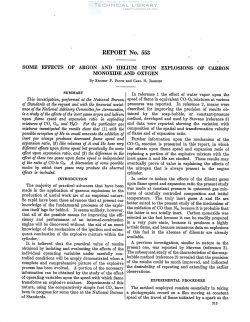naca-report-553

- Version
- 152 Downloads
- 1.08 MB File Size
- 1 File Count
- August 30, 2016 Create Date
- August 30, 2016 Last Updated
National Advisory Committee for Aeronautics, Report - Some Effects of Argon and Helium Upon Explosions of Carbon Monoxide and Oxygen

This investigation, performed at the National Bureau
of Standards at the request and with the jinancial assist—
ance of the National Advisory Committee for Aeronautics,
is a study of the ejects of the inert gases argon and helium
upon flame speed and expansion ratio in exploding
mixtures CO, 02, and H20. For the particular gas
mixtures investigated the results show that (1 ) with the
possible exception of He in small amounts the addition of
inert gas always produces decreased flame speed and
expansion ratio, (2) like rolumes of A and He have very
difi’erent efi'ects upon flame speed but practically the same
efi’ect upon expansion ratio, and (3) the difl'erence in the
eject of these two gases upon flame speed is independent
of the ratio of CO to 0,. A discussion of some possible
modes by which inert gases may produce the observed
ejects is included.
The majority of practical advances that have been
made in the application of gaseous explosions to the
production of useful work are of an empirical nature.
So rapid have been these advances that at present our
knowledge of the fundamental processes of the explo-
sion itself lags far behind. It seems unlikely, however,
that all of the possible means for improving the effi-
ciency and performance of an internal-combustion
engine will be discovered without the aid of an exact
knowledge of the mechanism of the ignition and subse-
quent combustion of the explosive mixture within the
cylinder.
It is believed that the practical value of results
obtained by isolating and evaluating the effects of the
individual operating variables under carefully con-
trolled conditions will be amply demonstrated when a
complete and comprehensive picture of the explosive
process has been evolved. A portion of the necessary
information can be obtained by the study of the effect
of operating variables upon the speed with which flame
transforms an explosive mixture. Experiments of this
nature, using the comparatively simple fuel CO, have
been in progress for some time at the National Bureau
of Standards.
| File | Action |
|---|---|
| naca-report-553 Some Effects of Argon and Helium Upon Explosions of Carbon Monoxide and Oxygen.pdf | Download |

Comment On This Post